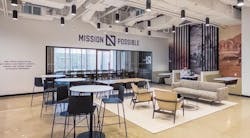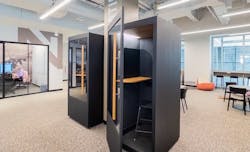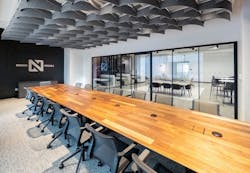Dyer Brown Designs New Boston HQ for Global Procurement Leader NOBLE, Optimized for Hybrid Work and Growth
Dyer Brown has completed a state-of-the-art headquarters for NOBLE, a leading global supplier to U.S. military and government agencies, located on Boston's waterfront. This 12,700-square-foot space is designed to support NOBLE’s growth ambitions and evolving hybrid work model, with fewer dedicated desks and more collaborative zones tailored for flexibility and team interaction. Through close collaboration with NOBLE’s leadership, the firm created a brand-aligned environment that reflects the company’s culture, emphasizing adaptability, teamwork, and a dynamic setting aimed at attracting top talent.
According to Dyer Brown’s Sara Ross, the 12,700-square-foot workplace is the result of a close partnership between her team of designers and a committee composed of NOBLE department heads. The approach ensured clarity on all headquarters project goals and an orderly process for steering their workplace concepts and design solutions toward supporting organizational goals most effectively.
“Noble’s CEO and executives made clear that in-person collaborative work is essential to their success and realizing growth potential,” said Sara Ross, LEED AP, principal and director of Enterprise Services for Dyer Brown. “They also wanted to be competitive in recruitment and retention of talented professionals, so creating a leading-edge workplace that would put them even more prominently ‘on the map,’ so to speak — with appealing amenities and a vibrant culture focused on teamwork — was a priority.”
Ross notes that recent national surveys indicate worker preferences increasingly favor hybrid work arrangements, striking a balance between remote and in-office hours, a factor taken into account in the design of a new headquarters for NOBLE.
A Leading-Edge Workplace
The client-consultant collaboration effort led by Dyer Brown began with engagement in a focused pre-design visioning process, kicking off with a survey of NOBLE’s departmental leaders to produce a concrete set of workplace operations and design goals. The visioning results revealed an emphasis on celebrating company culture, supporting collaborative work modes, and integrating flexibility into the space to accommodate changes in workflow and anticipated growth. The department heads then formed a design committee, which met regularly with the project team led by Ross.
The result is a crisp, appealing and amenity-rich setting for employees to be comfortable and optimally productive, with a brand-inspired yet sophisticated aesthetic befitting a global procurement and logistics provider to the world’s largest government and military entities. The centerpiece is a reception lounge that doubles as a community space for informal meetings or a quick lunch — visitors see this area first, giving them a window into Noble’s culture. Exploiting high ceilings and large window spans the design delivers an airy, bright atmosphere, with ceiling clouds to balance acoustics and define specific areas such as the primary conference table or the pantry amenity.
From the community space, corridors with overhead baffling serve as transition “tunnels” leading to the work areas drenched in natural daylight and featuring perimeter meeting rooms, huddle zones, phone booths, and a variety of furniture arrangements, representing a reduced emphasis on individual workstations. Aesthetically the design committee opted for a neutral palette dominated by black, white, grey, and natural wood finishes as a “backdrop” for the brand, with patterns, textures, and occasional pops of red as accents.
Throughout the workplace Noble’s company history and legacy are revealed through showcased products, displays of artifacts, and environmental graphics. According to Dyer Brown, the design truly reflects the company and its employees because their input formed the basis for all decision-making.
Ross adds, “More importantly, Noble leadership tells us the headquarters has helped them achieve short term goals for boosting in-person attendance, and they believe it will positively impact future recruitment efforts.”



